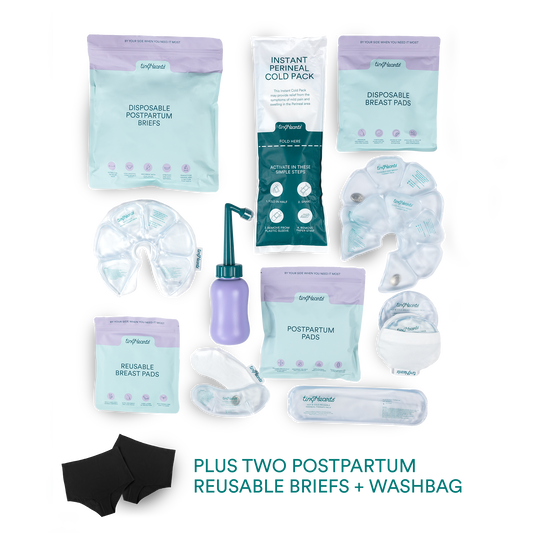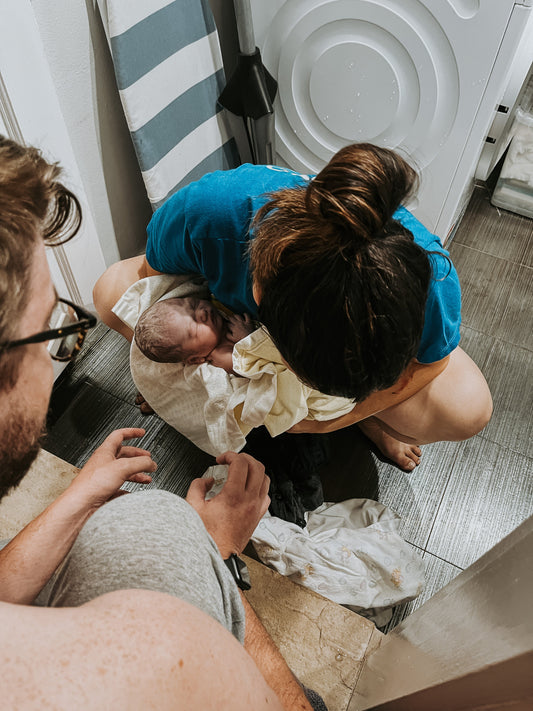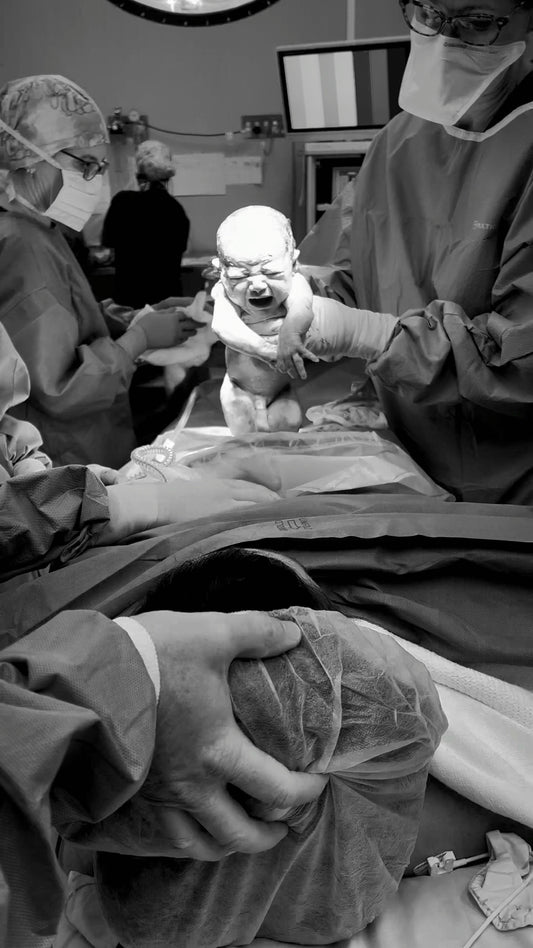There was so much I didn't know about when I welcomed my babies into the world.
As a mama who's been there before, I want to make sure you all know your options and what to expect before your little one is born. This is why I've penned down 10 things I wish I knew before entering the birth suite.
1. My skin-to-skin options
Skin-to-skin straight after birth helps to:
- Reduce newborn crying
- Start and sustain breastfeeding
- Maintain bub's body temperature
- Create a life-long bond!
If for whatever reason you are unable to perform skin-to-skin after birth, this will be offered to your co-pilot!
2. Your little one may want to breast crawl
A breast crawl involves the newborn babe being placed, skin to skin on mama's abdomen just after birth. Bub will use their senses, mainly smell, to find their way to the nipple.
If this is something you would like to do, request that all interventions are delayed until the breast crawl is complete and the first breastfeed is accomplished.
3. Breastfeeding is a SKILL
Excuse my language, but breastfeeding is fucking hard! Well, at least that was my experience.
This is coming from a mama who bottle-fed her first baby and breastfed her second baby. I think breastfeeding is portrayed on social media as a beautiful bonding experience, and don't get me wrong it can be.

Myself and my baby boy Wolf.
But just like my pic up here we are not showing the tears, the unsettled babe, the millions of positions we tried to get a good latch, the constant thought of "which boob now?" and the constant worry of "did he get enough?'"
One thing that helped me when I was struggling in the early days was repeating this; "it's called BREASTfeeding, not nipple feeding".
I gave up and went to formula early with Nahla because I didn't understand how important latch and positioning was and also I didn't reach out for professional support.
This mantra helped me to remember it all starts with a good latch. This understanding and visual changed my breastfeeding journey with Wolf, and instead of giving up, I kept at it and fed him for six months which was my goal.
This video is the perfect visual of BREASTfeeding, demonstrating just how much boob bub needs to feed successfully.
Once I understood the latch and how to get it right by working with Wolfie, I had no more pain, no more cracked nipples, and it was actually enjoyable.
4. Cord clamping options
When you have a baby, you often see the co-pilot cutting the cord, and that's it, but you have two options: immediate or delayed.
Immediate is when the cord is cut as soon as bub is born (I did this with both of my bubs).
Delayed cord clamping is when, as the name suggests, the clamping is delayed.
Benefits of doing this include:
- Bubs will receive extra blood from the placenta at birth so that the body can store more iron
- Iron helps the body to build red blood cells and other cells
- Studies are still in their infancy, but delayed cord clamping is linked to minor improvements in childhood development
- Delayed cord clamping in premmie babies can reduce the need for blood transfusions and reduce the risk of brain and bowel complications
Disadvantages of delayed cord clamping include:
- As bub is receiving extra blood from the placenta, a build-up in a chemical produced in this process called bilirubin can cause jaundice
- If your bub develops jaundice, they may need to undergo phototherapy
It's also important to note here that delayed cord clamping isn't always an option, for example, if your bub needs extra help once they're born.
5. Assisted birth is actually common
26% of women giving birth for the first time had an assisted vaginal birth - which is when tools like forceps, vacuums and episiotomies are used. Of that, 26% - 75% needed an episiotomy.
30% of women also had a caesarean birth (that's me!)
6. Birthing options for a caesarean (yes, you can have music!)
I've had two caesareans births and even if you end up having an emergency caesarean chat with your birth team about having music playing, lighting options, your requests for skin-to-skin, clamping the cord etc. There is usually time to make room for this stuff.
If it's not possible and it's a high-risk delivery, your care providers will let you know.
One incredible thing I wish I had the chance to chat with my birth team about was catching my baby as they joined the world earthside.
This is becoming increasingly common, and if the birth has little complications, it should be an option for you.
Here is an amazing example of this happening in Dr Joseph Sgroi's birth suite!
7. Placenta delivery options
There are two ways you can deliver your placenta after bub is born.
The midwife may pull on the umbilical cord to deliver the placenta and may ask you to help by gently pushing.
Or you may be offered an injection in your thigh just as the baby is born, to speed up the delivery of the placenta. The injection contains a drug called syntocinon (a synthetic version of the hormone oxytocin), which makes the womb contract and helps to prevent heavy bleeding known as a postpartum haemorrhage.
8. Having a birth plan
And when I say having a birth plan - I mean planning for the best AND planning for the worst. Something I didn't do with my first and as a result, was totally caught off-guard when I needed an emergency caesarean, and she had to go to the NICU once born.
When we talk about planning your birth, you should, of course, plan out the ideal scenario of what you would like to happen and how you would like to meet your baby. BUT I also want you to consider EVERY possible scenario, so there are no surprises on game day. With your co-pilot, you need to be asking each other:
- What happens if we need a caesarean?
- What happens if we need to be induced?
- What happens if I need an episiotomy?
- What happens if mama or bub needs care in the ICU or NICU?
- What are my options for pain relief? What do I want to try? When do I want to try it?
- Is there anything you are whole-heartedly opposed to?
- How are we going to manage feeds at home?
- How are we going to share the parental load?
By having plans in place before labour and childbirth, this will help you to feel confident and united as a team in your decision-making well beyond the birth of your little one.
9. Your baby might look different from what you expect.
All babies are so incredibly cute when they're born and while I know you're not expecting your bub to be born into the world fresh like they are on the movies - in addition to any amniotic fluids, your baby may:
Be covered in Vernix
Vernix is a white coating found on bub when they are born. It occurs naturally in the last trimester of pregnancy, and it's responsible for some pretty downright amazing things.

By @kindnessgirl
Be born with a 'conehead'
A newborn's skull bones are soft, thin and flexible, meaning their head can change shape easily and might look a little odd. This can be caused by the head's position in the uterus during pregnancy or because of the squishy passage down the birth canal. It will usually fix itself within about six weeks.

By @birthstoriesbyalexandriamooney
Be covered in fuzz
There might be a soft, peach fuzz covering your baby's back, shoulders, arms and feet when they are born. It's officially known as lanugo and is actually the first hair made by the body! Newborns need this extra layer to protect their skin and regulate their body temperature in the womb. Lanugo usually falls out within a week after birth, but for some, especially those bubbas born prematurely, it can last a bit longer.

By @sarahfairlight
Be born en-caul
An en-caul birth occurs when the infant is born inside the entire amniotic sac. The sac balloons out at birth, with the child remaining inside the unbroken or partially broken membrane. This is super rare - occurring in fewer than 1 in 80,000 births!
10. Being EDUCATED AF
If you're expecting and feeling overwhelmed and unsure of the road ahead, then you MUST do a birth course.
Being a paramedic, I had delivered babies in the past, but I was nowhere near ready or prepared when my first daughter was born. My husband was the same.
We developed our Bump, Birth and Beyond so we could prepare parents like you for every stage of labour, birth and the first few precious weeks with your little one - so you and your co-pilot can feel empowered and confident to face parenthood without fear.
Knowledge is POWER!







